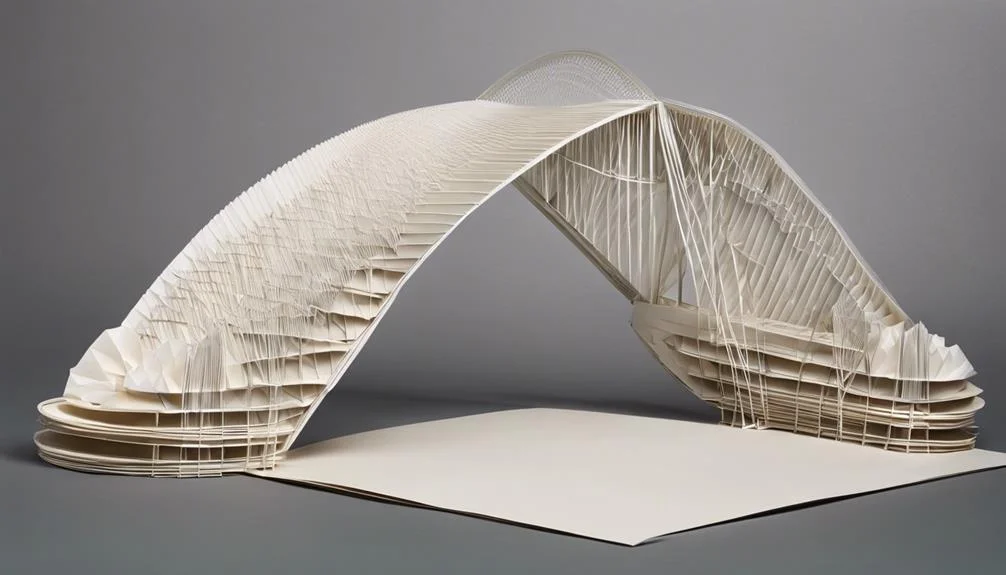Takeaways:
- These bridges face maintenance challenges and are prone to corrosion, potentially increasing long-term costs.
- They are aesthetically pleasing, with design flexibility allowing for various elegant and symmetrical configurations.
- Their construction and presence can impact local ecosystems, though sustainable practices may minimize environmental footprint.
| Pros of Cable-stayed Bridges | Cons of Cable-stayed Bridges |
|---|---|
| Aesthetic Appeal | Vulnerability to Extreme Weather |
| Cost-Effectiveness | Limitations on Load Capacity |
| Structural Efficiency and Flexibility | Complex Maintenance Requirements |
| Rapid Construction | Difficulty in Spanning Extremely Long Distances |
| Design Versatility | Risk of Vandalism |
| Environmental Compatibility | Potential for Vibration Issues |
| Suitability for Medium to Long Spans | Challenges in Aesthetic Integration |
| Durability | Environmental Impact During Construction |
| Adaptability to Different Terrains | Security Concerns |
| Enhanced Safety Features | Cost Variability |
Pros of Cable-stayed Bridges
- Aesthetic Appeal: Cable-stayed bridges offer a visually striking design that can become iconic symbols for the cities or regions where they are located. Their sleek profiles and distinctive patterns created by the cables contribute significantly to the landscape, often turning these structures into tourist attractions. For instance, the Millau Viaduct in France is not only functional but also a piece of architectural beauty, attracting visitors from around the world.
- Cost-Effectiveness: Compared to other types of large-span bridges, cable-stayed bridges are relatively inexpensive to build and maintain. This cost efficiency stems from the direct transfer of loads from the bridge deck to the towers via the cables, which minimizes the materials and foundational supports needed. This design principle was crucial in the construction of the Sunshine Skyway Bridge in Florida, where budget considerations were as important as structural integrity.
- Structural Efficiency and Flexibility: The design of cable-stayed bridges allows for a strong and flexible structure that can adapt to various environmental conditions. The cables can be adjusted to distribute loads evenly, enhancing the bridge’s ability to withstand heavy traffic, wind, and even seismic activities. The Russky Bridge in Russia exemplifies this, designed to endure the extreme weather conditions of its location.
- Rapid Construction: The construction process of cable-stayed bridges is relatively fast and efficient, thanks to prefabricated sections that can be quickly assembled on-site. This advantage was notably demonstrated in the building of the Tempozan Bridge in Japan, where the speed of construction minimized disruptions to the surrounding area.
- Design Versatility: Cable-stayed bridges offer a wide range of design options, allowing engineers to tailor each bridge to specific site conditions and aesthetic preferences. This versatility can be seen in the diverse appearances of cable-stayed bridges worldwide, from the streamlined simplicity of the Alamillo Bridge in Spain to the complex elegance of the Queensferry Crossing in Scotland.
- Environmental Compatibility: These bridges often require less material for construction, leading to a smaller environmental footprint compared to other bridge types. The use of fewer materials contributes to less disruption of the natural landscape and habitats during construction, a principle that was a key consideration in the design of the Øresund Bridge connecting Denmark and Sweden.
- Suitability for Medium to Long Spans: Cable-stayed bridges are ideal for covering medium to long distances, offering a practical solution for crossing rivers, canyons, or estuaries where traditional bridges might not be feasible. The Akashi Kaikyo Bridge in Japan, holding the record for the longest central span of any cable-stayed bridge, demonstrates this capability.
- Durability: With a lifespan of 50 to 100 years, cable-stayed bridges are designed to be durable and long-lasting. Proper maintenance can extend their life even further, making them a sustainable choice for infrastructure development. This durability is crucial for ensuring the long-term functionality and safety of major transport links.
- Adaptability to Different Terrains: The flexible design of cable-stayed bridges allows them to be constructed over various terrains, including water bodies, urban areas, and valleys. This adaptability makes them a preferred choice for challenging sites, where other types of bridges might not be suitable.
- Enhanced Safety Features: Cable-stayed bridges incorporate advanced engineering techniques that contribute to their overall safety. The cables not only support the deck but also provide additional stability against potential hazards such as earthquakes and strong winds, ensuring the safety of commuters. The Normandy Bridge in France is a testament to this, designed with safety as a paramount concern.
Cons of Cable-stayed Bridges
- Vulnerability to Extreme Weather: Cable-stayed bridges can be susceptible to damage from extreme weather conditions, including hurricanes, typhoons, and heavy snowfalls. The exposure of cables and decks to the elements requires careful consideration during the design phase to mitigate potential risks. The Tacoma Narrows Bridge in the United States is a historical example of how wind can affect bridge stability.
- Limitations on Load Capacity: While strong and flexible, cable-stayed bridges may face challenges in carrying extremely heavy loads compared to some other bridge types. This limitation necessitates careful planning and load management to ensure the bridge’s longevity and prevent structural strain.
- Complex Maintenance Requirements: The unique structure of cable-stayed bridges, particularly the cables and anchorages, requires specialized maintenance techniques. Accessing these components for inspection and repair can be challenging and costly, as seen in the maintenance efforts for the Brooklyn Bridge in New York.
- Difficulty in Spanning Extremely Long Distances: Despite their suitability for medium to long spans, cable-stayed bridges may not always be the best option for extremely long distances. The engineering and economic challenges of such spans can limit their application, as evidenced by the considerations in planning bridges over vast expanses like the Strait of Gibraltar.
- Risk of Vandalism: The exposed cables of cable-stayed bridges can be targets for vandalism, posing a risk to the structure’s integrity and safety. Protecting these critical components requires additional security measures, as demonstrated by the increased surveillance and fencing around vulnerable areas of the Golden Gate Bridge.
- Potential for Vibration Issues: The design of cable-stayed bridges can make them susceptible to vibrations caused by wind, traffic, or seismic activity. Engineers must incorporate damping systems to counteract these vibrations, as was done in the design of the London Millennium Bridge, which experienced noticeable swaying on its opening day.
- Challenges in Aesthetic Integration: While often admired for their beauty, the distinctive appearance of cable-stayed bridges can sometimes clash with the surrounding environment or historical context. Achieving aesthetic harmony requires thoughtful design and consideration of the local landscape, as seen in the debate over the visual impact of the proposed Garden Bridge in London.
- Environmental Impact During Construction: Despite their generally lower environmental footprint, the construction of cable-stayed bridges can still have significant impacts on local ecosystems, particularly in sensitive or protected areas. Mitigating these impacts requires comprehensive environmental assessments and planning, as was undertaken for the construction of the Sutong Bridge in China.
- Security Concerns: The prominent and accessible nature of cable-stayed bridges can raise security concerns, necessitating measures to protect against potential threats. This has led to the implementation of security protocols and surveillance systems, as seen in the security upgrades for the George Washington Bridge post-9/11.
- Cost Variability: While generally cost-effective, the actual construction and maintenance costs of cable-stayed bridges can vary widely based on location, materials, and design complexity. Unexpected increases in costs can pose challenges to budgeting and financial planning, as experienced with the escalating costs associated with the construction of the Bay Bridge in San Francisco.
Design and Aesthetics
Cable-stayed bridges are renowned for their visually striking designs, which are characterized by elegant cable patterns and towering structures, offering both aesthetic appeal and design versatility. These bridges stand out as architectural marvels in urban and natural landscapes alike, seamlessly blending functionality with aesthetic elegance. The design flexibility inherent in cable-stayed bridges allows for a variety of configurations, including side-spar, cantilever-spar, and multiple-span systems. This adaptability not only caters to the specific needs of a project but also enables architects and engineers to push the boundaries of modern design.
The aesthetic impact of these bridges on city skylines and natural landscapes cannot be overstated. Their imposing presence and graceful lines enhance the visual appeal of their surroundings, making them landmarks in their own right. Furthermore, the symmetrical design options available in cable-stayed bridges contribute significantly to their stability and structural integrity, ensuring that their beauty is matched by their resilience.
Rigging configurations such as mono, parallel, fan, and star designs not only add to the visual drama of these bridges but also offer unique performance benefits, optimizing the balance between form and function. This blend of aesthetic versatility and structural performance underscores the significance of cable-stayed bridges in contemporary infrastructure.
Construction Process

The construction process of cable-stayed bridges, characterized by both efficiency and flexibility, typically commences with the erection of towering support structures. This is followed by the strategic attachment of cables to distribute the deck load. This method not only expedites the overall construction timeline but also ensures a high degree of stability and rigidity throughout the process.
The inherent design flexibility of cable-stayed bridges allows for a variety of configurations, further optimizing construction efficiency and effectiveness.
To better understand this construction process, consider the following key points:
- Faster Construction Time: Compared to other bridge types, cable-stayed bridges can be constructed more quickly due to the simplified process of erecting towers and attaching cables.
- Rigidity and Stability: The cable support system provides exceptional rigidity and stability during construction, minimizing potential delays.
- Design Flexibility: The construction process benefits from the ability to adapt the bridge design to specific site conditions, enhancing both aesthetic appeal and structural integrity.
- Cost-Effectiveness: While the focus here is not on cost, it’s important to note that the efficiency of the construction process contributes to the overall cost-effectiveness of cable-stayed bridges.
These aspects highlight the sophisticated yet practical approach to constructing cable-stayed bridges, making them a preferred option for spanning medium-length distances.
Cost Efficiency

Moving into the analysis of cost efficiency regarding cable-stayed bridges, it is crucial to examine both initial construction expenses and the long-term maintenance costs.
The financial viability of these structures is underscored by their relatively lower upfront building costs and the economical nature of their ongoing upkeep.
This dual aspect of cost efficiency not only makes them a preferred choice for new projects but also offers sustainable financial benefits over the lifespan of the bridge.
Initial Construction Expenses
When evaluating the cost efficiency of bridge designs, it becomes apparent that cable-stayed bridges offer significant advantages in initial construction expenses, being approximately 30% cheaper to build than their counterparts. This cost-effectiveness stems from several key factors:
- Reduced Raw Materials: Cable-stayed bridges require fewer materials for construction, directly lowering the initial cost.
- Lower Labor Hours: The simpler design and construction process of cable-stayed bridges demand less labor, further reducing expenses.
- Minimal Support Structures: The design of cable-stayed bridges minimizes the need for extensive support structures, making them more affordable to construct.
- Medium-Length Span Efficiency: For medium-length spans, cable-stayed bridges are the preferred choice due to their lower initial construction expenses, offering a cost-efficient solution without compromising on quality or durability.
Long-Term Maintenance Costs
Assessing the long-term cost efficiency of cable-stayed bridges reveals that their maintenance expenses can be notably lower than those of alternative bridge designs. These structures benefit from requiring less material and labor for maintenance throughout their lifespan, which translates into significant cost savings.
Proper maintenance routines are key to avoiding expensive repairs and structural issues, ensuring the bridge remains safe and operational. Regular inspections and diligent upkeep not only extend the durability and lifespan of cable-stayed bridges but also contribute to their overall cost-effectiveness.
Despite the initial higher construction costs associated with these bridges, the long-term maintenance expenses are generally more affordable, making them a financially viable option for large-scale infrastructure projects.
Durability and Maintenance
Cable-stayed bridges, known for their resilience against natural disasters like earthquakes, face challenges in maintenance and durability due to their complex design. While these structures stand as marvels of modern engineering, achieving a balance between their aesthetic appeal and practical longevity requires addressing several critical issues.
- Inspection and Repair Challenges: The intricate cable bundles that characterize cable-stayed bridges pose significant hurdles in regular inspections and repairs. These components are critical for the bridge’s stability and require meticulous attention to detect and address any signs of wear or damage.
- Corrosion Susceptibility: Particularly in coastal areas, the metal parts of cable-stayed bridges are at a high risk of corrosion. This not only compromises the bridge’s structural integrity but also necessitates frequent and costly maintenance efforts.
- Specialized Materials Requirement: To combat rust and corrosion, cable-stayed bridges must utilize advanced materials that offer long-term protection. These materials often come at a higher initial cost but are essential for the bridge’s durability.
- Accumulating Maintenance Costs: Despite the potential for initial cost savings in construction, the ongoing expenses related to maintaining a cable-stayed bridge can significantly impact its overall cost-effectiveness and longevity.
Environmental Impact

The environmental impact of cable-stayed bridges encompasses several critical considerations, including:
- Habitat disruption
- Emissions from construction activities
- Alterations to natural landscapes
These structures, while architecturally striking, can interfere with wildlife habitats and migration patterns, contribute to air and water quality degradation during their construction and ongoing maintenance, and alter the visual aspects of natural and urban environments.
Addressing these issues requires comprehensive environmental assessments and the implementation of effective mitigation strategies to minimize their ecological footprint.
Habitat Disruption Potential
Environmental impacts of cable-stayed bridges include significant habitat disruption, particularly through alterations in water flow and wildlife migration. The construction and maintenance of these structures pose a series of environmental challenges, impacting terrestrial and aquatic ecosystems.
To understand the extent of habitat disruption, consider the following:
- Alteration of Water Flow: Changes in water dynamics can impact aquatic life and sediment transport, affecting riverbank ecosystems.
- Wildlife Migration Patterns: Disruption can impede the natural movements of wildlife, leading to ecological imbalances.
- Deforestation and Habitat Destruction: The clearing of land for bridge construction can result in significant loss of habitat for various species.
- Noise and Pollution: Increased noise levels and potential pollution from construction and maintenance activities can adversely affect both terrestrial and aquatic wildlife.
Addressing these challenges requires careful planning and mitigation strategies to minimize environmental impact.
Construction Emission Concerns
Significant emissions result from the construction of cable-stayed bridges, encompassing transportation, machinery use, and the production of materials. The deployment of heavy machinery and equipment during these construction phases significantly contributes to air pollution. These emissions are not just localized concerns but have broader implications for air quality and the global climate change crisis.
Addressing these environmental impacts requires a commitment to minimizing construction emissions through meticulous planning and the adoption of sustainable practices. Implementing sustainable construction methods, such as the utilization of eco-friendly materials and the optimization of transportation routes, stands out as a crucial strategy. These measures not only help in reducing the carbon footprint associated with construction activities but also pave the way for a more environmentally responsible approach to infrastructure development.
Natural Landscape Alterations
Beyond addressing construction emissions, it is essential to consider how cable-stayed bridges reshape natural landscapes, affecting ecosystems and visual aesthetics. The architectural demands of these structures, including tall towers and extensive cable networks, necessitate significant alterations to the existing environments. These changes have multifaceted implications:
- The need for tall towers and long cables can lead to considerable modifications of the natural landscape.
- Construction often involves clearing vegetation and altering the terrain, disrupting local flora and fauna.
- The impact on local ecosystems and wildlife habitats during the construction phase can be substantial, altering migration patterns and food sources.
- The visual presence of cable-stayed bridges transforms the aesthetic appeal of natural surroundings, affecting both the local environment and human perception.
Environmental assessments play a critical role in mitigating these impacts, ensuring that the benefits of such structures are balanced with the need to protect and preserve natural landscapes.
Safety Features

Cable-stayed bridges are renowned for their inherent safety features, stemming from a robust structural design that efficiently supports heavy loads. This architectural approach not only ensures the longevity of the structure but also significantly enhances user safety. One of the most notable safety advantages of cable-stayed bridges is their rigidity, which provides unparalleled stability in cross-wind conditions. This characteristic is crucial for maintaining safety during adverse weather conditions, where other bridge types might falter.
Furthermore, cable-stayed bridges are designed to maintain their structural integrity under heavy traffic, a feature that directly translates to safety for the thousands of vehicles and pedestrians that may use the bridge daily. The cables themselves play a pivotal role in this aspect, offering consistent support and rigidity to the bridge deck, which is essential for the bridge’s overall safety performance.
Adding to their impressive safety features, cable-stayed bridges exhibit remarkable resilience against natural disasters, including earthquakes. This resilience is attributed to their design flexibility, which allows them to absorb and dissipate seismic forces more effectively than many other bridge types. Consequently, cable-stayed bridges offer an extra layer of safety for users, making them a preferred choice in earthquake-prone areas.
Architectural Significance

The striking design of cable-stayed bridges not only serves a functional purpose but also elevates them to the status of architectural marvels within urban landscapes. Their modern and striking architectural design has not only become a hallmark of contemporary infrastructure but also a symbol of innovative engineering and aesthetic appeal. These bridges, with their unique cable arrangements, create visually appealing structures that stand out, transforming the skylines of cities around the globe.
To understand their architectural significance, consider the following:
- Innovative Appearance: Cable-stayed bridges showcase sleek designs that represent the cutting edge of architectural innovation. Their streamlined appearance adds a modern touch to the surrounding environment.
- Iconic Landmarks: Architects have leveraged the unique aesthetics of cable-stayed bridges to craft iconic landmarks, making them focal points in cities worldwide.
- Visual Appeal: The distinct cable patterns not only serve structural purposes but also contribute to the visual intrigue and beauty of these bridges, making them subjects of admiration and inspiration.
- Engineering and Aesthetics Blend: These bridges exemplify how engineering prowess can be seamlessly blended with aesthetic considerations, leading to structures that are both functional and strikingly beautiful.
Cable-stayed bridges, therefore, not only connect points but also bridge the gap between utility and artistry, playing a pivotal role in modern architectural achievements.
Conclusion
In conclusion, cable-stayed bridges represent a significant advancement in bridge engineering, combining aesthetic appeal with structural efficiency.
Their design flexibility, rapid construction, and cost-effectiveness are counterbalanced by challenges related to maintenance, susceptibility to environmental conditions, and geographical limitations.
Despite these issues, the durability, safety features, and minimal environmental impact of cable-stayed bridges underscore their importance in modern infrastructure.
As engineering techniques evolve, these structures will likely continue to play a pivotal role in bridging the gaps in global transportation networks.










